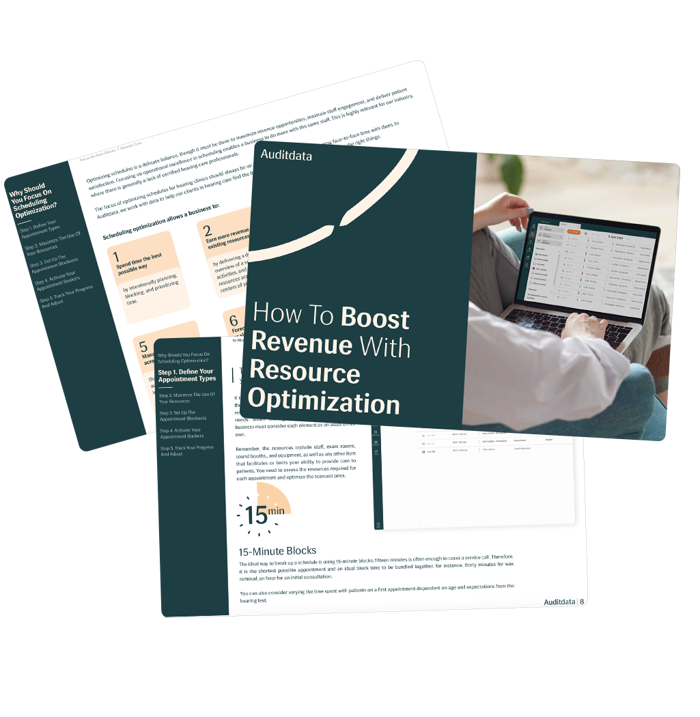
As hearing care clinics grow and open new locations, one of the biggest challenges is doing more with limited staff, without sacrificing quality.
Staffing shortages, inconsistent workflows, and disconnected systems can slow down even the most experienced clinics. Whether you're expanding into new regions or managing multiple locations, optimizing how you use staff, time, and equipment is key to delivering consistent, high-quality care across your network.
Private Hearing Clinics
The industry is growing worldwide as the market is expanding. The solution for many retailers to comply with this is to open more clinics. But opening new clinics (or acquiring them) is expensive and a hassle to get started. Each time you open a new clinic, you start from scratch. Moreover, there is a lack of trained audiologists in most countries meaning that staffing is costly and difficult. So, what can you do to get more clients through your clinics?
Hospital Hearing Care
There are waiting lists for hearing treatment, and the audiologists in the clinics struggle to get all their patients treated. But do all patients need to see an audiologist to get going in the hospital system? And how can we get more patients through the tight bottlenecks of staff, budgets, and resources in the hospitals?
3 Ways To Improve Resource Utilization
We have to make sure that the audiologists spend their time where it matters, which is with the hearing-impaired people, and that they deliver high-quality treatment to these people. So, the next question is then – how to do that?
1. Unify Your Scheduling Strategy to Maximize Capacity Across Clinics
When streamlining resources in hearing care, schedule optimization is often overlooked, yet it’s one of the most powerful ways to improve patient flow, staff productivity, and clinic performance. Optimizing schedules involves prioritizing face-to-face time with patients.
That’s where our next-generation scheduler, part of Auditdata’s Practice Management Software, comes in. It acts as a central scheduling hub across all your locations, helping you:
-
Balance workloads across clinics and staff
-
Gain real-time visibility into availability and appointment trends
-
Enable remote access and cross-location scheduling
-
Standardize workflows through staff training and system-wide practices
→ Segment Appointments
Not every patient interaction requires the same amount of time. Start by segmenting your schedule using 15-minute blocks — a flexible unit that can be bundled to fit different appointment types.
-
Quick service call? 15 minutes may be enough.
-
Wax removal? Book 30 minutes.
-
First consultation? Reserve 60 to 75 minutes, adjusting based on patient age and expectations.
By tailoring appointment lengths, you increase availability and reduce bottlenecks.
→ Split Tasks Across Your Team
Your most specialized resources, like your audiologists, should focus on high-value clinical tasks. Delegate operational or routine tasks (like intake forms or follow-ups) to assistants or admin staff.
If facility space is your limiting factor, break appointments into smaller modules to reserve rooms only when necessary. This helps you maximize use of every resource, people, rooms, and equipment.
→ Block Calendars Strategically
Avoid random bookings that lead to calendar gaps. Instead, block out time for longer, harder-to-schedule appointments first, then fill in remaining time with shorter visits. This structured approach helps eliminate downtime and improves appointment flow across the day.
→ Train Your Booking Staff
The bookers must have access to a central scheduler and know when to book which appointments with patients. Housing your scheduler in the cloud is a smart way to provide central access, especially if you have multiple clinics or audiologists.

Free Guide
How to Boost Revenue with Resource Optimization
With a few simple adjustments to your schedule or diary, you can get much more out of your existing resources and focus more on the clients. The following E-book outlines 5 steps to implement that maximizes revenue, delivers opportunities, and visualizes all staff and resource availability.

2. Protect Audiologist Time by Pre-Qualifying Patients
One of the biggest bottlenecks is the audiologists’ time. To use it effectively, every patient they see should have a clear need for treatment. There are two scalable ways to achieve this, and they work best together.
Start by training all front desk staff to follow a standardized set of qualification questions during booking. Ask why the person thinks they have hearing loss, what they’re experiencing day to day, and how it affects their life. If their answers strongly suggest hearing loss, book a longer appointment. If not, book a shorter slot with time upfront to assess whether further care is needed.
➡ Questions To Ask:
- Do you have hearing aids today?
- When did you get the hearing aids?
- Have you had your hearing tested before?
- Is anyone telling you, that you don’t hear well?
- Do you hear well in noisy surroundings?
- Do mind me asking how old you are?

To support this process, equip non-clinical staff with tablet-based hearing screeners. These quick tests help identify patients who may need treatment, reducing strain on audiologists and ensuring time is reserved for those who need it most.
3. Standardize Testing Protocols Across Clinics for Consistency and Quality
To optimize both time usage and the quality of hearing evaluations, it’s essential to implement a standardized testing procedure — one that’s based on best practices and regularly refined. This ensures that all staff follow the same clinical workflow, supporting consistent care across locations, whether in hospitals or private clinics.
Automating these workflows with clinical software helps ensure procedures are followed correctly every time. This not only improves patient outcomes but also saves valuable time.
For audiologists, it means being guided step by step through evaluations, increasing confidence and consistency. It also makes onboarding new staff easier, as the system supports and nudges them to follow the recommended flow — even flagging deviations from the standard when needed.
For clinic owners or heads of audiology, automation makes performance measurable.
With ongoing staff shortages in audiology, maximizing each team member’s time is more important than ever. Centralized scheduling, automated workflows, and performance reporting are critical to improving efficiency, ensuring consistent quality, and driving better care across your network.
Other Blogs You Might Enjoy

Top 6 Operational Challenges That Can Stop Your Clinic From Achieving Success
You strive to offer the best hearing care with exceptional customer service, but certain operational challenges can prevent your hearing clinic from achieving (or maximizing) success. If you’re using inefficient scheduling systems, improper workflows, or outdated equipment, your business – and your customers – will be negatively impacted.

What Is a Tablet-Based Hearing Screener and How Can It Benefit Your Clinic?
Hearing care providers work tirelessly to attract people to their clinics to screen them for hearing loss. If these folks are unable to visit the hearing care clinics in person, audiologists need to be mobile enough to come to them, using portable tablet hearing screeners.

What Hearing Clinics Can do to Promote Hearing Health
People may prioritize some aspects of their physical health – getting checkups and screenings like colonoscopies – but may pay less attention to their hearing health – an important part of their overall well-being. This blog will explore what hearing clinics can do to promote hearing health and drive key behaviors.
Don't Miss Out On the Latest Insights On Audiology
Sign up today to receive exciting updates, tips, and the latest newsletters from Auditdata.